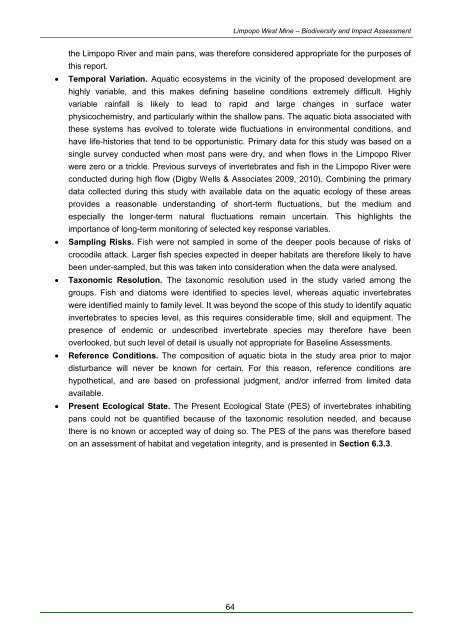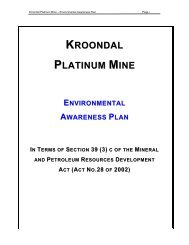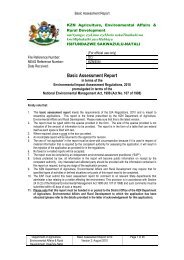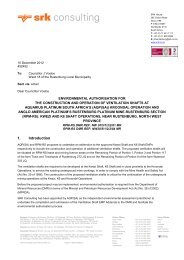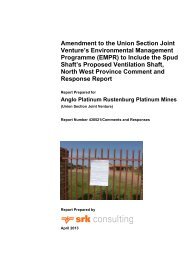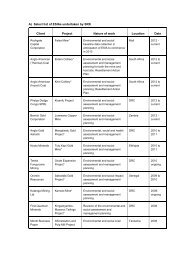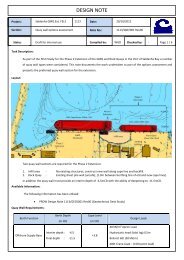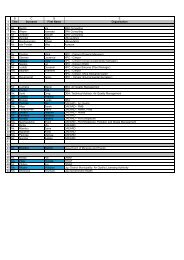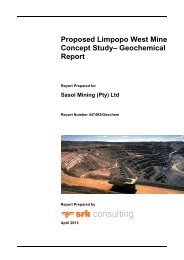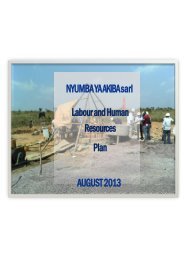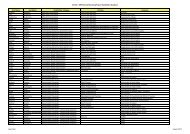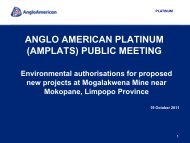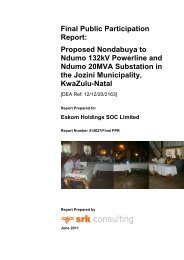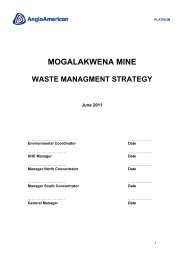Table of Contents - SRK Consulting
Table of Contents - SRK Consulting
Table of Contents - SRK Consulting
You also want an ePaper? Increase the reach of your titles
YUMPU automatically turns print PDFs into web optimized ePapers that Google loves.
Limpopo West Mine – Biodiversity and Impact Assessmentthe Limpopo River and main pans, was therefore considered appropriate for the purposes <strong>of</strong>this report.Temporal Variation. Aquatic ecosystems in the vicinity <strong>of</strong> the proposed development arehighly variable, and this makes defining baseline conditions extremely difficult. Highlyvariable rainfall is likely to lead to rapid and large changes in surface waterphysicochemistry, and particularly within the shallow pans. The aquatic biota associated withthese systems has evolved to tolerate wide fluctuations in environmental conditions, andhave life-histories that tend to be opportunistic. Primary data for this study was based on asingle survey conducted when most pans were dry, and when flows in the Limpopo Riverwere zero or a trickle. Previous surveys <strong>of</strong> invertebrates and fish in the Limpopo River wereconducted during high flow (Digby Wells & Associates 2009, 2010). Combining the primarydata collected during this study with available data on the aquatic ecology <strong>of</strong> these areasprovides a reasonable understanding <strong>of</strong> short-term fluctuations, but the medium andespecially the longer-term natural fluctuations remain uncertain. This highlights theimportance <strong>of</strong> long-term monitoring <strong>of</strong> selected key response variables.Sampling Risks. Fish were not sampled in some <strong>of</strong> the deeper pools because <strong>of</strong> risks <strong>of</strong>crocodile attack. Larger fish species expected in deeper habitats are therefore likely to havebeen under-sampled, but this was taken into consideration when the data were analysed.Taxonomic Resolution. The taxonomic resolution used in the study varied among thegroups. Fish and diatoms were identified to species level, whereas aquatic invertebrateswere identified mainly to family level. It was beyond the scope <strong>of</strong> this study to identify aquaticinvertebrates to species level, as this requires considerable time, skill and equipment. Thepresence <strong>of</strong> endemic or undescribed invertebrate species may therefore have beenoverlooked, but such level <strong>of</strong> detail is usually not appropriate for Baseline Assessments.Reference Conditions. The composition <strong>of</strong> aquatic biota in the study area prior to majordisturbance will never be known for certain. For this reason, reference conditions arehypothetical, and are based on pr<strong>of</strong>essional judgment, and/or inferred from limited dataavailable.Present Ecological State. The Present Ecological State (PES) <strong>of</strong> invertebrates inhabitingpans could not be quantified because <strong>of</strong> the taxonomic resolution needed, and becausethere is no known or accepted way <strong>of</strong> doing so. The PES <strong>of</strong> the pans was therefore basedon an assessment <strong>of</strong> habitat and vegetation integrity, and is presented in Section 6.3.3.64


